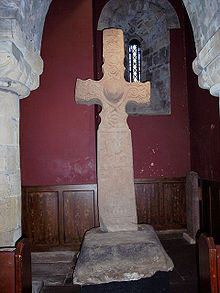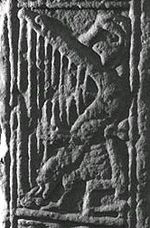- Dupplin Cross
-
The Dupplin Cross is a carved, monumental Pictish stone, which dates from around 800A.D. It was first recorded by Thomas Pennant in 1769, on a hillside in Strathearn, a little to the north (and on the opposite bank of the river Earn from) Forteviot and Dunning. In 2002 it was placed in the care of Historic Scotland, and was placed for preservation under the 12th century tower of St Serf's church in Dunning (also in the care of Historic Scotland). Open to the public April-September.
The Dupplin Cross is a high cross, that is a free-standing stone cross. While relatively common in Ireland, Northumbria and in Dál Riata, such crosses are rare survivals in the lands of the Picts, though fragments of shattered crosses (probably cast down during the 16th century Reformation) show that a number once existed. Early records report that a second cross, 'Cross of Dronachy', stood on the lands of Invermay, south of Forteviot and also overlooking Forteviot, but this is now lost. The cross base survives in situ, but the records do not provide details of its exact form.
The cross is carved from Old Red Sandstone, the cross stands about 2.5 metres tall, 1 metre broad over the arms of the cross. It is carved with various scenes, religious, martial and traditional Pictish animal carvings. The cross contains a partially legible inscription, of which only the name CUSTANTIN FILIUS FIRCUS can be read. This name is taken as the Latin form of the early 9th century Pictish king's Gaelic name Caustantín son of Fergus (fl. 793–820).
Since the inscriptio implies that the Cross was carved either during, or shortly after, the reign of Caustantín, it is particularly important as giving a fixed point in the chronology of Pictish sculpture. It also indicates that Gaelic was spoken at the time as it uses the Gaelic personal name of his father in Latin.
External links
Aberlemno Sculptured Stones · Bullion Stone · Camus Cross · Drosten Stone · Dunnichen Stone · Dupplin Cross · Eassie Stone · Glamis Manse Stone · Hunter's Hill Stone · Meigle standing stones · Monifieth Sculptured Stones · St Orland's Stone · Woodwrae StoneAnglo-Saxon Bewcastle Cross · Crowle Stone · Dartmoor crosses · Easby Cross · Gosforth Cross · Legg's cross · Ruthwell Cross · Sandbach Crosses · Sheffield CrossIrish Ardboe High Cross · several at Clonmacnoise · Iona Abbey · Kildalton Cross · Muiredach's High Cross · St. Tola's Cross · several at TuamPictish Camus Cross · Dupplin CrossCornish Categories:- Archaeological sites in Perth and Kinross
- High crosses
- Historic Scotland properties
- Medieval Scotland
- Pictish stones
- Monumental crosses in the United Kingdom
Wikimedia Foundation. 2010.


